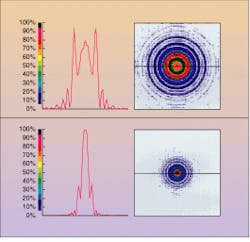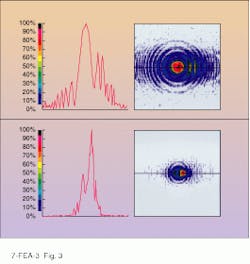GILLES MATHIEU
Since the first ray-trace package was released, optical design software has been continuously improved and made more user friendly. Conventional packages allow designers to correct aberrations in imaging systems but do not always take into account the actual operating conditions that the system will experience. Such conditions include use of extended sources with specific radiance and intensity, interaction between photon and matter, coupling of detectors or optical fiber, and the non-sequential propagation of photons.
Optis has developed the Solstis optical design package to incorporate all of these aspects in the design process. The program contains modules dedicated to photometry in optical systems, wavefront propagation with diffraction effects, and coupling in multimode or single-mode fibers.
Designing a laser projector
To illustrate the capabilities of the software, consider the analysis of an argon-ion-laser-based projector. The beam is modulated and deflected outside of the cavity by an acousto-optic crystal, with a maximum deflection range of 3°. The divergence of the beam is reduced through a beam expander. This projector is designed to operate with a screen at an undefined distance, so the beam is not focused to a specific location.
The goal of the designer was to determine the best optics for the system by analyzing the beam for varying distances and incident angles. (see Fig. 1). Using traditional optical design software to analyse such a system is not practical for two reasons. First, the system input is a Gaussian wavefront rather than a plane wave or point source. Second, the modulation transfer function (MTF) and point spread function (PSF) used by conventional optical design software are not useful for a configuration that has a collimated beam and for which the location of the focal plane is not specified.
On the other hand, the Solstis Laserpro module is able to analyze this system because it can account for the coherence of the light, the nonuniform wavefront, aberrations, and diffraction effects. The user can model a wide range of laser sources, including hermite-Gaussian lasers (TEM00, TEM01, TEMxx) and single-mode diode lasers. The module also supports user-defined beams using phase and amplitude parameters in the near or far field.
Analyzing the laser projector system
For a chosen source, Solstis/Laserpro calculates the wavefront and field characteristics in the image field. The user simply has to specify the focal plane of the laser beam to see immediately an irradiance map or a phase map on the screen. For the laser projection system being modeled, on-axis irradiance distributions were calculated for focal planes at 4 m and 8 m from the projector (see Fig. 2). The optical system provides a better beam shape at 8 m than at 4 m, where the irradiance distribution shows significant power diverted into the side lobes.The irradiance calculation can be repeated to examine system performance for angular deflection of the source. Distributions for the focal plane at 4 m and 8 m were calculated for a deflected angle of 1.5° (see Fig. 3). Once again the beam shape is quite good at 8 m. In addition to assessing the general performance with the irradiance distributions, it is possible to observe multiple reflection effects with some smaller rings appearing to the right of the image.
The final projector has been successfully designed for a range of 6 to 25 m. As in other cases, the results have been validated, with better than 5% accuracy. This degree of accuracy is also available for calculating the coupling efficiency in single-mode fibers.
Conventional ray trace software could have been used to design the optical system in the argon-ion laser projector, but a good flat-field solution would have entailed a large number of lenses with complex shapes, difficult to fabricate and expensive. The Solstis optical design software allows the user to perform design iterations while modeling realistic operating conditions, quickly arriving at the best and least expensive design solution. The program can also be used for designing and analyzing laser printers and laser markers.
Gilles Mathieu is technical manager at Optis, ZE La Farlède, BP 275, 83078 Toulon cedex 9, France.


